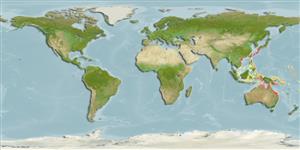>
Ovalentaria/misc (Various families in series Ovalentaria) >
Pomacentridae (Damselfishes) > Microspathodontinae
Etymology: Parma: Latin, parma, -ae = a little shield.
More on author: Whitley.
Environment: milieu / climate zone / depth range / distribution range
Ecología
marino asociado a arrecife; no migratorio; rango de profundidad 2 - 20 m (Ref. 7247). Tropical
Distribución
Países | Áreas FAO | Ecosistemas | Ocurrencias, apariciones | Point map | Introducciones | Faunafri
Western Pacific: eastern Australia between Cape Tribulation, Queensland and Sydney, New South Wales.
Tamaño / Peso / Age
Maturity: Lm ? range ? - ? cm
Max length : 16.5 cm SL macho / no sexado; (Ref. 7247)
Short description
Morfología | Morfometría
Espinas dorsales (total): 2; Radios blandos dorsales (total): 17-20; Espinas anales 2; Radios blandos anales: 13 - 15
Museum specimens indicate that this species is probably most abundant in non-coral reef coastal waters, although one specimen at the Australian Museum was taken at Great Island on the Great Barrier Reef, Australia. Life history characteristics for the family specify that this group is oviparous, with distinct pairing during breeding (Ref. 205). Eggs are demersal and adhere to the substrate (Ref. 205). Males guard and aerate the eggs (Ref. 205). Diurnal species (Ref. 113699).
Life cycle and mating behavior
Madurez | Reproducción | Puesta | Huevos | Fecundidad | Larva
Life history characteristics for the family specify that this group is oviparous, with distinct pairing during breeding (Ref. 205). Eggs are demersal and adhere to the substrate (Ref. 205). Males guard and aerate the eggs (Ref. 205).
Allen, G.R., 1991. Damselfishes of the world. Mergus Publishers, Melle, Germany. 271 p. (Ref. 7247)
IUCN Red List Status (Ref. 130435)
Threat to humans
Harmless
Human uses
Más información
Age/SizeCrecimientoLength-weightLength-lengthLength-frequenciesMorfometríaMorfologíaLarvaDinámica larvariaReclutamientoAbundanciaBRUVS
ReferenciasAcuiculturaPerfil de acuiculturaRazasGenéticaElectrophoresesheritabilidadEnfermedadesProcesamientoNutrientsMass conversion
Herramientas
Special reports
Download XML
Fuentes de Internet
Estimates based on models
Preferred temperature (Ref.
123201): 24.3 - 28.2, mean 26.9 °C (based on 680 cells).
Phylogenetic diversity index (Ref.
82804): PD
50 = 0.5010 [Uniqueness, from 0.5 = low to 2.0 = high].
Bayesian length-weight: a=0.01950 (0.00922 - 0.04124), b=3.00 (2.82 - 3.18), in cm total length, based on LWR estimates for this (Sub)family-body shape (Ref.
93245).
Nivel trófico (Ref.
69278): 2.7 ±0.24 se; based on food items.
Resiliencia (Ref.
120179): Medio, población duplicada en un tiempo mínimo de 1.4-4.4 años (Preliminary K or Fecundity.).
Fishing Vulnerability (Ref.
59153): Low vulnerability (10 of 100).
Nutrients (Ref.
124155): Calcium = 81.5 [41.5, 129.3] mg/100g; Iron = 0.655 [0.404, 1.069] mg/100g; Protein = 18.2 [17.1, 19.4] %; Omega3 = 0.101 [0.063, 0.161] g/100g; Selenium = 23.1 [13.1, 42.9] μg/100g; VitaminA = 83.2 [22.9, 279.6] μg/100g; Zinc = 1.59 [1.10, 2.29] mg/100g (wet weight);
